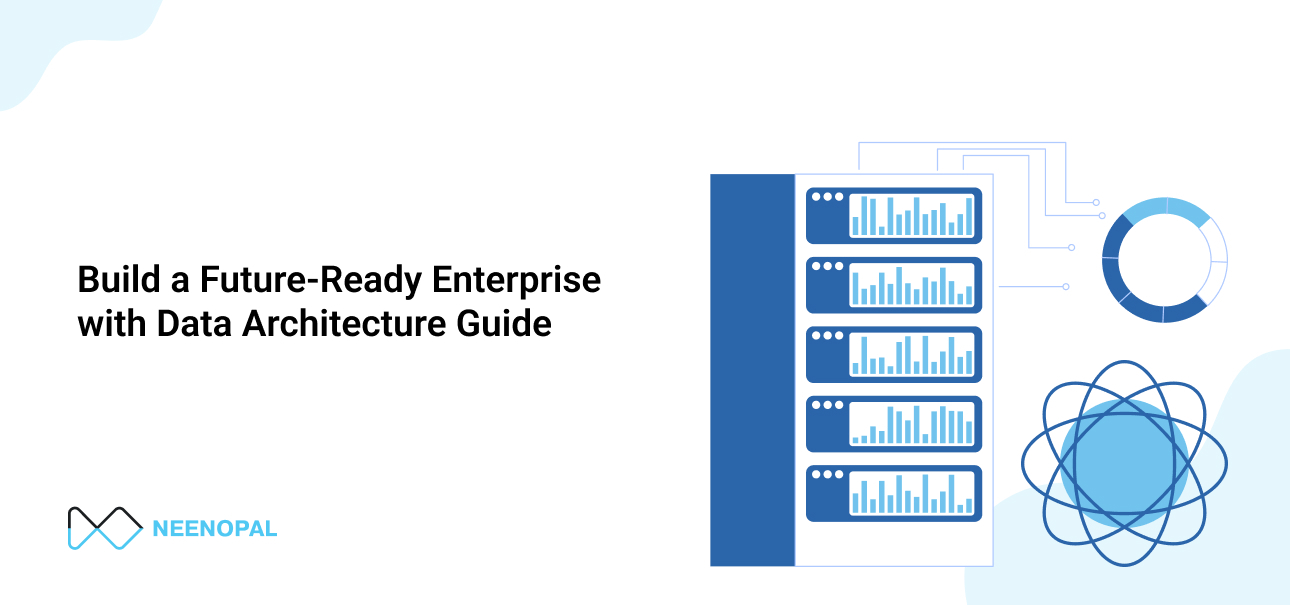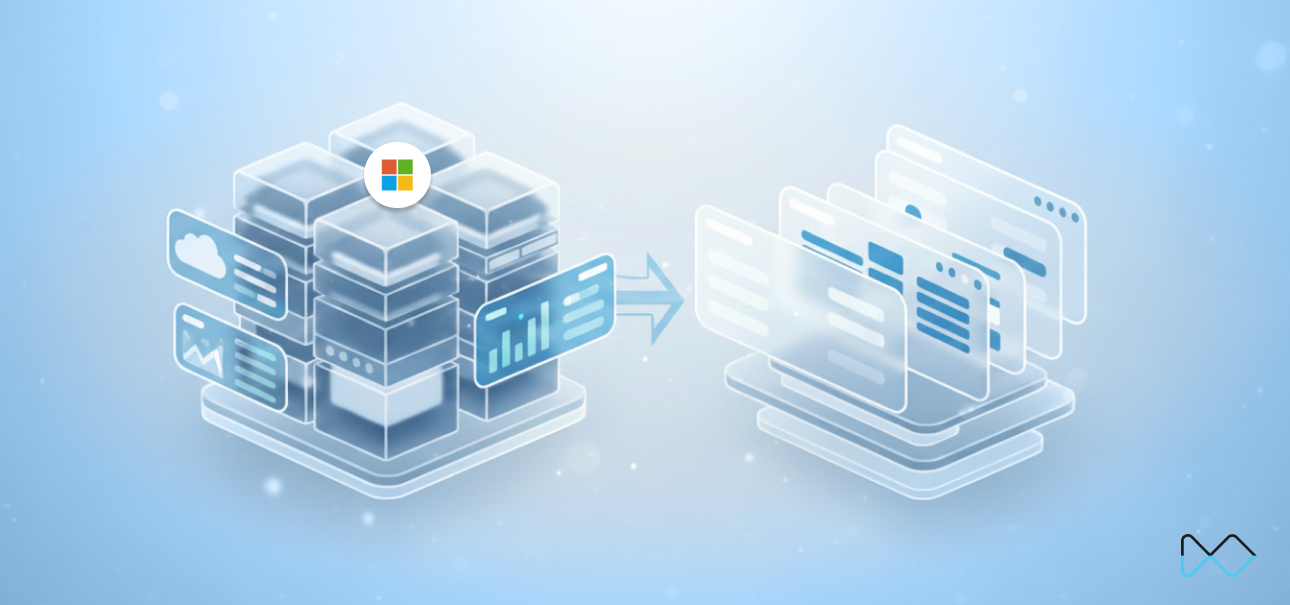Can Your Data Architecture Keep Up With Tomorrow’s Demands?
In today's data-driven world, organizations are grappling with ever-increasing volumes, variety, and velocity of data. To harness this influx for strategic advantage, a structured and well-defined Enterprise Database Architecture (EDA) is no longer a luxury but a necessity. An effective EDA acts as a comprehensive framework for designing and implementing data systems that align with organizational goals, supporting efficient data management, optimized performance, and scalable systems to meet future demands.
This guideline serves as a framework for data architects, IT strategists, decision-makers, and key stakeholders responsible for enterprise-level data systems. It guides data strategy alignment with business goals and ensures effective data governance, usability, and scalability. Furthermore, an enterprise data architecture roadmap helps organizations plan and execute their data initiatives systematically, enabling them to unlock significant value from their information assets.
By implementing a structured data architecture, businesses can unlock significant value.
Why Structured Data Management is Crucial for Business Intelligence, Analytics, and Compliance
A well-defined Enterprise Data Architecture underpins successful business intelligence, data analytics, and regulatory compliance. The applications of EDA span all facets of data management, including collection, storage, processing, analysis, and governance.
Organizations that implement a well-defined architecture can achieve several key outcomes:
-
- Improve decision-making through reliable data insights.
- Enable scalability as data volumes and sources grow.
- Enhance collaboration between technical and business teams.
- Ensure data quality, security, and compliance.
Reliable insights are the backbone of informed decision-making. However, even the most sophisticated architecture can fail if reporting systems are mishandled. As NeenOpal’s BI checklist highlights, a single mishandled null or silent field rename can undo months of work. Embedding such safeguards into the architecture ensures accuracy and consistency across business dashboards. Furthermore, a standardized architecture fosters better communication and cooperation between IT and business departments, ensuring data solutions directly support strategic goals. Finally, robust data quality, security, and compliance measures built into the architecture are essential for protecting sensitive information and adhering to increasingly stringent regulations.
Core Elements of an Effective Enterprise Data Architecture

Building a robust EDA involves several critical components. It starts with understanding the fundamental requirements and aligning them with overarching business objectives.
1. Requirements Definition Aligned with Business Goals
The foundational step is defining requirements aligned with business goals, ensuring that the EDA supports the organization's strategic objectives and operational needs. This involves identifying business needs and use cases, such as sales forecasting or customer behavior analytics. It also requires understanding and prioritizing business priorities, like cost reduction or data-driven innovation, and defining critical data flows and dependencies.
Strategic Alignment with Objectives and KPIs: Strategic alignment ensures that data initiatives directly support organizational goals, creating a clear link between business priorities, technical systems, and data governance. Key components include:
-
- Mapping Organizational Goals to Data Initiatives: This links high-level business priorities with data initiatives to ensure measurable outcomes, focusing on the "why" behind each initiative. Workshops with senior leadership can identify initiatives that support the broader Enterprise Analytics Strategy. Outcome Mapping visualizes how initiatives like analytics or AI capabilities contribute to specific business outcomes. For example, if the goal is to increase market share, a relevant initiative could be building a customer segmentation model.
- Defining KPIs (Key Performance Indicators): KPIs measure whether a data initiative achieves its intended business impact, ensuring accountability and measurable progress. These metrics should directly tie to organizational outcomes and focus on business impact rather than system performance. Frameworks like SMART (Specific, Measurable, Attainable, Relevant, Time-Bound) can be used to define KPIs. Examples of business-centric KPIs include increasing customer retention, reducing manual reporting time, or increasing revenue through cross-selling. For a company aiming to reduce operational delays, a KPI might reduce the time needed to resolve supply chain bottlenecks by 20%.
Prioritization of Initiatives: Projects should be evaluated based on impact and feasibility to effectively prioritize data architecture initiatives. Strategic approaches include balancing Quick Wins vs. Long-Term Goals and conducting ROI Calculations.
-
- Quick Wins are low-effort, high-impact projects that deliver immediate value and build stakeholder confidence, like automating daily sales dashboards.
- Long-Term Goals are high-effort, high-impact initiatives that require more investment but provide significant long-term value, such as implementing a company-wide data lake. The Effort vs. Impact Project Matrix helps prioritize initiatives by evaluating required effort against potential impact, identifying low-effort, high-impact quick wins and high-effort, low-impact projects that may need reevaluation. ROI Calculations help evaluate the financial or operational benefits relative to cost, ensuring efficient resource use. Automating a report might offer a quick ROI, while implementing a data warehouse has high initial costs but drives long-term benefits like revenue growth and better decision-making.
2. Standard Implementation Cycle
A Standard Implementation Cycle provides a structured approach for deploying Enterprise Data Management Architecture in logical, manageable stages, ensuring alignment with overall business goals. The cycle typically includes the following phases:
-
- Discovery & Requirements Gathering: Engage stakeholders, analyze current infrastructure, and define user personas and compliance needs to establish a clear understanding of business needs, current capabilities, system requirements, and scope. Key activities include stakeholder engagement, current state assessment, definition of business requirements, technology assessment, and risk identification. Deliverables include a Business Requirements Document (BRD) and a Risk Register.
- Design & Initial Architecture: Develop a scalable, efficient, and secure architecture aligned with business needs and the technological environment. This involves system architecture design, data modeling, technology stack selection (including flexible, secure, and scalable solutions like cloud platforms), security planning, and scalability planning. Deliverables include System Architecture Diagrams and a Security and Compliance Checklist. Choosing architecture types like microservices can enhance scalability and efficiency.
- Development & Prototyping: Create a functional prototype or Minimum Viable Product (MVP) to validate core features and functionality and gather feedback. Agile methodology and CI/CD pipelines are recommended for incremental features and streamlined deployment. Deliverables include the MVP, Integration Test Results, and a User Feedback Report.
- Testing & Optimization: Validate the system's performance, functionality, and security through comprehensive testing, including functional, performance, and security audits, as well as User Acceptance Testing (UAT). Identified issues are resolved to optimize the system. Deliverables include Test Reports and Optimized System Performance Metrics.
- Go-Live & Continuous Improvement: Deploy the system into production with minimal disruption, provide user training and ongoing support, and continuously monitor the system for issues and gather feedback for optimization and new feature development. Deliverables include Production Environment Setup and a Post-Go-Live Support Plan.
3. Architectural Frameworks and Diagrams
Enterprise Data Architecture leverages various types of architectures to structure data systems effectively. Understanding these frameworks is crucial for selecting the right approach for specific business needs.
-
- Centralized Architecture: All data storage, processing, and management occur in a single location or system, acting as a "single source of truth". It offers advantages like data consistency, ease of management, simpler querying, and reduced complexity, being cost-effective for smaller workloads. However, it may face scalability issues, act as a single point of failure, encounter performance bottlenecks under heavy loads, and have geographical limitations. Examples include data warehouses like Snowflake and legacy on-premises databases.
- Distributed Architecture: Data storage, processing, and access are spread across multiple nodes or locations, allowing parallel processing and improved fault tolerance. This architecture is designed for horizontal scalability, fault tolerance, performance optimization through parallel processing, and global accessibility. Its disadvantages include complex management, potential data consistency issues, latency in coordination, and higher operational costs. Examples include Big Data Processing Tools like Amazon EMR and NoSQL Databases like Amazon DynamoDB.
- Client-Server Architecture: A distributed computing framework where clients request services from servers over a network. Components include clients (web browsers, apps) and servers (web, database, file servers). Data flows through a request-response cycle using protocols like HTTP/HTTPS. Use cases include web applications and e-commerce platforms, enabling modularity, scalability, and efficient resource management.
- Cloud-Centered Architecture: The core infrastructure, services, and resources are hosted on cloud platforms, leveraging their scalability, flexibility, and cost-efficiency. It commonly uses cloud services for storage, compute, databases, and networking, often integrating on-premises systems via a data integration layer. A critical security layer is needed to ensure data privacy and secure communication. This architecture is typical in applications requiring high availability and global accessibility. Use cases include predictive maintenance and supply chain optimization.
- Layered Architecture: Organizes a system into distinct, hierarchical layers (e.g., User Interaction, Functionality, Business Rules, Application Core, Database Layer), promoting separation of concerns and reducing dependencies. Each layer interacts only with the adjacent layer, making the system more maintainable, scalable, and flexible. It's widely used in enterprise and web applications.
- Event-Driven Architecture (EDA): Components communicate through events, making systems highly scalable, responsive, and capable of real-time processing. Components include Producers (generate events), Event Buses/Message Brokers (route events), and Consumers (process events). This architecture is ideal for applications like financial systems, IoT, and modern web applications.
With event-driven frameworks, businesses can enable systems that respond in real time. NeenOpal’s deep dive into Agentic AI systems operating with goal-oriented autonomy shows how AI, when paired with robust data architecture, can power smarter workflows and proactive decision-making.
4. Documentation and Versioning
Comprehensive documentation and rigorous version control are essential for maintaining clarity, standardization, and continuity in Enterprise Data Architecture.
Technical and Process Documentation: Serves as a guide for stakeholders to understand and maintain the architecture. Its purpose is knowledge sharing, standardization, troubleshooting, and compliance. Key components include:
-
- Architecture Overview (high-level diagrams).
- System Design Details (configurations, data flows, dependencies).
- Process Documentation (data ingestion, transformation, access).
- Roles and Responsibilities (data stewards, administrators).
- Best Practices and Guidelines (security, scalability, efficiency).
- Change Management protocols.
Version Control: Critical for tracking, managing, and coordinating changes to documentation, configurations, and code. Its purpose is traceability, collaboration, and recovery (rollback). Implementation involves using versioning strategies like Semantic Versioning (MAJOR.MINOR.PATCH), tools like Git, and collaborative platforms like GitHub, and processes like branching and merging, maintaining change logs, and implementing access controls. Regular documentation updates are also part of version control.
By integrating a clear understanding of what is enterprise architecture into these frameworks, organizations can establish structured, efficient, and future-ready data systems that align with strategic business goals.
Essential Best Practices for Data Management Success

Implementing specific best practices ensures your enterprise data systems' health, security, and effectiveness. These include:
-
- Data Governance Framework: Establish organization-wide policies to standardize data definitions, formats, and access controls. Appointing data stewards ensures accountability for data quality and integrity. This framework is crucial for mitigating data silos by providing a unified approach to data management.
- Data Quality: Ensure the integrity and usability of data across disparate systems. Mitigation strategies for data silos, such as a unified data platform and metadata management, inherently contribute to improved data quality.
- Metadata Management: Maintain a centralized metadata repository to provide context about data sources, definitions, and usage. Using metadata to create a lineage tracks data origins, transformations, and destinations, ensuring transparency and traceability. This is a key strategy for mitigating data silos.
- Access Control: Implement robust, centralized access control policies to protect sensitive data and ensure compliance with regulations. Role-based permissions can prevent unauthorized changes.
- Cloud-Native Solutions: Utilizing cloud infrastructure (IaaS, PaaS, SaaS) and cloud-native services (like AWS Lambda, Azure Functions) is key for building scalable and modular architectures. Cloud platforms offer flexibility, rapid deployment, and cost optimization through pay-as-you-go models.
Navigating Common Challenges in Enterprise Data Architecture

Implementing and maintaining an effective EDA can present challenges. The guideline outlines key cautions and provides mitigation strategies.
-
- Mitigation of Data Silos: Data silos lead to inefficiencies, inconsistent reporting, and limited collaboration. Risks include data inconsistency and integration complexities. Mitigation strategies involve adopting a unified data platform (like data lakes or data warehouses), establishing a data governance framework, using APIs for seamless communication, fostering a data-driven culture, implementing metadata management, designing a scalable and modular architecture, and continuous monitoring.
NeenOpal’s recognition with the AWS Data & Analytics Services Competency underscores the importance of cloud-native approaches that eliminate silos, ensure compliance, and provide scalable analytics. Such strategies align closely with the principles of a future-ready Enterprise Data Architecture.
- Regulatory Compliance: Regulations like GDPR and HIPAA impose strict rules on data handling, and integrating data silos can trigger compliance requirements, including data localization. Risks include severe penalties for non-compliance, reputational harm, and exposing data through integration efforts. Mitigation involves implementing auditable workflows, using privacy-by-design principles, employing regional data centers, and partnering with compliance experts.
- Avoid Vendor Lock-In: Over-reliance on specific vendors can limit flexibility and innovation. Risks include hidden costs, limited compatibility, and inflexibility in switching providers. Mitigation strategies include choosing open-source frameworks, using APIs and microservices architectures, employing hybrid-cloud solutions, and planning for exit strategies.
- Overengineering Risks: Prioritizing theoretical needs over practical solutions can lead to overly complex and costly designs. Risks include project bloat, increased latency, and longer deployment cycles. Mitigation involves focusing on business objectives, using modular design principles, performing regular design reviews, and planning for scalability over time. While modularity and scalability are often beneficial, the Amazon Prime Video case study highlighted that sometimes a monolithic approach can be more efficient for specific requirements, demonstrating the value of evaluating trade-offs.
- Mitigation of Data Silos: Data silos lead to inefficiencies, inconsistent reporting, and limited collaboration. Risks include data inconsistency and integration complexities. Mitigation strategies involve adopting a unified data platform (like data lakes or data warehouses), establishing a data governance framework, using APIs for seamless communication, fostering a data-driven culture, implementing metadata management, designing a scalable and modular architecture, and continuous monitoring.
Conclusion
Building a well-defined Enterprise Data Architecture and Data Architecture Roadmap is fundamental to navigating the complexities of the modern data landscape. By leveraging expert data architecture services to align requirements with business goals, following a structured implementation cycle, understanding different architectural frameworks, prioritizing documentation and versioning, and implementing key best practices like data governance, data quality, metadata management, and access control, organizations can build scalable, resilient, and compliant data systems that drive business intelligence and data analytics. Addressing potential challenges like data silos, regulatory compliance, vendor lock-in, and overengineering through proactive mitigation strategies is also vital for long-term success.
Implementing these principles allows businesses to transform their data into a strategic asset, fueling innovation and maintaining a competitive edge.
Ready to transform your data landscape and unlock the full potential of your data?
NeenOpal specializes in helping businesses design and implement robust Enterprise Data Architectures and Roadmaps that are aligned with strategic goals. We provide expert data consulting services tailored to your unique needs, focusing on delivering measurable business value.
Contact us today for a consultation or explore our data management solutions to learn how we can help you build a future-ready enterprise.
Frequently Asked Questions
1. What is Enterprise Data Architecture, and why is it important?
Enterprise Data Architecture (EDA) is a framework for managing data systems across an organization. It ensures efficient data management, supports analytics, improves decision-making, and helps businesses stay compliant with regulations. A strong EDA provides scalability, security, and alignment with business goals.
2. How does data architecture support business intelligence and analytics?
A well-defined data architecture ensures data quality, consistency, and accessibility, which are essential for business intelligence and analytics. By centralizing and governing data, organizations gain reliable insights, enabling smarter decisions, predictive modeling, and compliance with industry standards.
3. What challenges do businesses face when building an enterprise data architecture roadmap?
Common challenges include data silos, regulatory compliance, vendor lock-in, and overengineering. Companies can overcome these by implementing a clear data governance framework, adopting scalable cloud-native solutions, and aligning their data architecture roadmap with business objectives.






